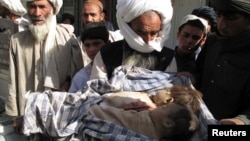The administration of Afghan President Hamid Karzai has spent more than $45 million from the national treasury over the last eight years to compensate civilian casualties of the U.S.-led war, although most were caused by Taliban insurgents.
Amid the ongoing drawdown of U.S. forces, day-to-day conflict remains a reality for many people in Afghanistan, where the death or injury of a household breadwinner can be catastrophic.
“For each martyred, 100,000 Afghanis [about $1,800] and ... 50,000 Afghanis have been paid [for each wounded],” Karzai spokesman Aimal Faizi told VOA Dari service, explaining that a total 12,212 payments have been allocated to families of “martyrs,” with another 11,642 issued to wounded individuals.
But Karzai’s condolence payments aren't limited to victims of military operations by pro-government forces, and they aren't restricted exclusively to cash remittances. A vast majority of recipients were harmed in Taliban attacks or U.S.-NATO counterinsurgency operations, and, moreover, the Afghan government’s ad hoc sympathy program has funded Hajj pilgrimage costs of over 4,400 individuals, resulted in the distribution of land, facilitated the creation of educational scholarships and resulted in reimbursement for medical expenses.
But the government program hasn't reached every civilian casualty of the war. At least 15,628 civilian deaths — along with many thousands of injuries — were recorded by the UN from January 2009 to June 2014 alone.
U.S.-NATO payments
As the U.S. winds down the longest war in its history, civilian casualties resulting from U.S.-led counterinsurgency operations have dropped markedly. UN figures show only one percent of civilian casualties reported in the first half of 2014 — 1,564 deaths, 3,289 wounded — were caused by international forces.
The U.S. military's sharp reduction in the killing and injuring of Afghan civilians has, beyond the obvious political and moral advantages, palpable economic benefits. Fewer American taxpayer dollars are spent on civilian victims of anti-Taliban operations now than before.
While Kabul-based U.S.-NATO spokesperson Jennifer Bragg says the alliance doesn't have “centralized figures” to show how much it paid to compensate for civilian casualties over the past years, it was reported in 2011 that U.S. military had spent millions.
In one of the largest payments ever made, families of the 16 civilians shot dead by Sergeant Robert Bales on March 11, 2014 in the southern Afghan province of Kandahar, were each paid $46,000. In general, however, U.S.-NATO forces have paid $2,500 for every civilian killed and $1,000 for any one injured in their military operations.
Amnesty International has criticized the U.S. for its alleged failure in delivering justice to Afghan civilian victims. In a recent report, the UK-based human rights group accused U.S.-NATO forces of “killing thousands” of Afghan civilians and failing to bring those responsible to justice and accountability.
Taliban’s promise of heaven
The UN figures attribute over 70 percent of all civilian casualties in Afghanistan to Taliban insurgents. Taliban’s suicide attacks, improvised bombings and targeted assassinations account for most of the UN reported civilian casualties.
The insurgent group, however, rejects these reports and says its fighters only target pro-government Afghan and foreign forces, civilian government employees and contractors.
In very rare cases when Taliban acknowledged civilian casualties, the group issued tersely worded regrets, saying the victims were “martyrs” who would be rewarded by Allah in the heavens. Although Diya, or blood money, is obligatory in Islamic jurisprudence, the militant organization does not pay civilian victims — killed or injured.
According to the UN reports, Taliban insurgents have caused more than 11,000 civilian deaths, and wounded thousands more, over the past five years. If Afghan government standards for civilian casualty compensation — $1,800 for each death; $900 for each wounded — applied to Taliban militants, the group would owe millions in financial payments to Afghan families.










